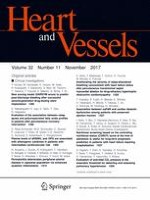Published in:

01-11-2017 | Original Article
Pre-existing medical comorbidity is not associated with neurological outcomes in patients undergoing targeted temperature management following cardiac arrest
Authors:
Arash Nayeri, Nirmanmoh Bhatia, Benjamin Holmes, Nyal Borges, Michael N. Young, Quinn S. Wells, John A. McPherson
Published in:
Heart and Vessels
|
Issue 11/2017
Login to get access
Abstract
The prognostic significance of chronic medical illness in comatose survivors of cardiac arrest who undergo targeted temperature management (TTM) remains largely unknown. We sought to assess the association between overall burden of pre-existing medical comorbidity and neurological outcomes in survivors of cardiac arrest undergoing TTM. We analyzed a prospectively collected cohort of 314 patients treated with TTM following cardiac arrest at a tertiary care hospital between 2007 and 2014. Overall burden of medical comorbidity was approximated with the use of the Charlson Comorbidity Index (CCI). Poor neurological outcome at hospital discharge, defined as a cerebral performance category (CPC) score >2, was the primary outcome. Secondary outcomes included death prior to hospital discharge and at 1 year following cardiac arrest. Multivariable logistic regression was used to assess the association between CCI scores and outcomes. A poor neurological outcome at hospital discharge was observed in 193 (61%) patients. One hundred and seventy-nine (57%) patients died prior to hospital discharge and a total of 195 (62%) patients had died at 1-year post-arrest. In multivariable logistic regression, elevated CCI scores were not associated with increased odds of poor neurological outcomes (OR 1.04, 95% CI 0.90–1.19, p = 0.608) or death (OR 0.99, 95% CI 0.86–1.13, p = 0.816) at hospital discharge. No association was seen between CCI scores and death at 1-year post-arrest (OR 1.09, 95% CI 0.95–1.26, p = 0.220). Increasing burden of medical comorbidity, as defined by CCI scores, is not associated with neurological outcomes or survival in patients treated with TTM.





